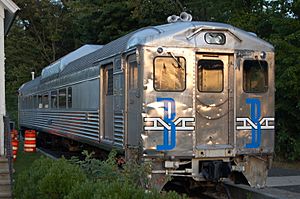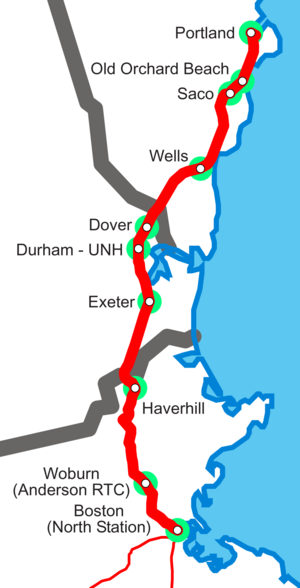Railroad history of Portland, Maine facts for kids
The railroad history of Portland, Maine, began in 1842. This was when the Portland, Saco & Portsmouth Railway (PS&P) first arrived. Most of the train activity in Portland focused on moving farm goods for export. It also handled import freight from Europe.
Portland had passenger train service for 125 years, from 1842 until 1967. Amtrak started serving the city again in 2001. For most of this time, passenger trains were for long trips. People traveled from Portland to Boston, Montreal, Nova Scotia, and other places. Daily commuting by train was not common.
Contents
Portland's Early Train History
Portland first became a major transportation spot in 1832. That's when the Cumberland and Oxford Canal opened, connecting to inland Maine. The first railroad came to the city 10 years later. This was the Portland, Saco & Portsmouth Railway (PS&P) in 1842. It worked with the Eastern Railroad of Massachusetts.
The PS&P's main station in Portland was on Commercial Street. Six passenger trains ran daily between Portland and East Boston. The Boston & Maine Railroad (B&M) also arrived in 1843.
Building New Rail Lines
Portland businessmen, like John A. Poor, worried that Boston's rail connections would hurt Portland's port. Poor wanted a separate system of railroads. These would bring goods from inland Maine directly to Portland. This system used a special track width called "Portland gauge." It competed with the "standard gauge" tracks going to Boston.
The Portland Company was started in 1846. It built locomotives for the Atlantic & St. Lawrence Railroad (A&SL). Trains from India Street in Portland reached Yarmouth in 1848. They finally reached Montreal in 1859.
Train services to Auburn, Lewiston, and Waterville began in 1849. These were on lines of the original Maine Central (MEC) system. The route to Brunswick opened in 1847. It was part of the Kennebec & Portland Railroad, which later joined the MEC.
Changes to Train Tracks and Services
The Portland gauge railways north of Portland were changed to standard gauge in the 1870s. The line from the India Street station to Montreal stayed independent. It became the Grand Trunk Railway. Other lines joined to form the Maine Central Railroad. The Boston and Maine Railroad took control of these in 1884.
Passenger service at Union Station mainly connected to Boston. But in 1913, the New York, New Haven and Hartford Railroad started a new service. It was called the State of Maine Express. This overnight sleeping car service went to Grand Central Terminal in New York City.
Portland's Train Stations
Portland once had four passenger train stations. These were Commercial Street, India Street (both near the water), Preble Street, and Union Station. In the early days, trains from the south ended at Commercial Street. Grand Trunk trains from the north ended at India Street.
In 1873, the B&M finished its line to Portland. Its northern station on Saint John Street was named Portland Union Station. As the B&M grew, the Commercial Street station became less important. It closed in 1894. The Preble Street station served the Portland & Rochester (P&R) line. This line later became part of the Boston & Maine. It closed in 1900, and P&R trains then used Union Station.
By 1903, Portland had two main passenger stations. These were the B&M/MEC Portland Union Station on Saint John's Street (rebuilt in 1888) and the Grand Trunk Terminal on India Street.
Today, the Portland Transportation Center serves Amtrak's Downeaster service. It was built specifically for the Downeaster on a former part of the Maine Central Railroad.
The Golden Age of Train Travel
Train service between Portland and Montreal began to slow down after 1923. That's when the Grand Trunk became part of the Canadian National Railway. In 1930, the Gull train started. It offered international sleeping car service between Boston and Halifax, passing through Portland.
In the 1920s, many companies offered passenger train services to Portland.
- Portland had two stations: Union Station and the Grand Trunk's India Street Terminal.
- Most passenger trains used Union Station. Only two daily Grand Trunk trains to Montreal used the India Street Terminal.
- Train schedules usually had trains leaving Portland in the morning and arriving in the evening.
- Sometimes, traveling to Lewiston meant changing trains in Brunswick.
How the Train Lines Worked

The train service between Portland and Lewiston Junction (where the Lewiston-Auburn airport is) ran along the Atlantic & St. Lawrence mainline. This line reached Yarmouth in 1848 and Lewiston Junction in 1849. During its construction, an impressive wooden viaduct (a long bridge) with a steel swing section was built. It crossed Back Cove in Portland and India Street. This bridge was used until 1984, when it was damaged by fire.
The Grand Trunk line from Yarmouth Junction to Lewiston Junction was a single track. It had places for trains to pass each other. It was never a double track. The Grand Trunk leased this line until 1923. Then, due to financial problems, the Canadian National Railway took it over. After the bridge fire in 1984, the line ended at East Deering.
Today, the part of the Grand Trunk line south of the burned bridge is used by the Maine Narrow Gauge Railway. It is also a walking path. In 1981, the Maine Central was bought by Guilford Rail System. This company still runs some freight trains east to Brunswick.
The Famous Flying Yankee Train
One of the most popular trains from Portland was the Boston-Portland-Bangor "Flying Yankee" route. The MEC and Boston & Maine Railroads ran it together. It made three daily trips from Portland Union Station.
On April 1, 1935, this service began with a brand new train. It was a diesel-powered, stainless steel, streamlined train. It had three connected cars and 142 seats. This was the first non-steam streamlined train in eastern North America. It was only the third in the entire United States.
The "Flying Yankee" traveled about 730 miles a day, Monday through Saturday. It went on a loop: Portland-Boston-Portland-Bangor-Portland-Boston-Portland. It could reach speeds of up to 100 miles per hour! After more than 23 years, the "Flying Yankee" made its last trips on May 7, 1957. It had traveled over five and a quarter million miles.
The End of Passenger Train Service
Passenger service on the P&R line completely stopped in 1932. By 1954, the Maine Central was using buses for some trips between Lewiston and Portland. For the trains that still ran, the trip time was much faster. It went from about 90 minutes in the 1920s to as little as 55 minutes. In 1954, the Grand Trunk still ran one daily train to Portland and Lewiston from Montreal.
As fewer people rode trains, the stations closed down. The India Street station lost its tall tower in 1948. The station building itself was torn down in 1966. Union Station in Portland was also torn down in 1961. However, its demolition helped start Portland’s movement to save historic buildings.
In the final years of passenger train service, the Gull and State of Maine trains stopped running in 1960. All passenger service on the Maine Central (Portland-Bangor) also ended in 1960. The Lewiston service stopped in the mid-1950s. The Boston & Maine ended its service between Boston and Portland in 1965. Finally, in 1967, the Grand Trunk Railway stopped its once-a-week summer service to Montreal. This ended all regular passenger train service to Portland and Lewiston.
Trains Return to Portland (Since 1980)
The Portland Downeaster
The Trainriders Northeast group was formed in Portland in 1989. Their main goal was to bring passenger train service back to Maine from Massachusetts. In 1990, the State of Maine began planning to restore this service. The Northern New England Passenger Rail Authority was created in 1995 to manage it.
The Amtrak Downeaster service began in December 2001. It offered four daily round trips to North Station in Boston. In October 2007, after more tracks were built, the schedule increased to five round trips on most days.
In Portland, the Downeaster ends at a station that combines train and bus services. It has a large parking lot and is located west of the Portland peninsula.
Brunswick Train Service
In June 1987, the State of Maine bought two train lines from the Maine Central Railroad. These were the 56-mile (90 km) Rockland Branch (between Brunswick and Rockland) and the Calais Branch.
A plan was discussed in 2009 to extend the Downeaster service to Brunswick. This would involve the train backing up at the Portland station. Then it would travel on a new connection to the main line towards Brunswick.
On January 28, 2010, the Northern New England Passenger Rail Authority (NNEPRA) received a $35 million grant. This money was for upgrading tracks and signals for the Portland-Brunswick line. Work began in summer 2010. Train service to Brunswick returned on November 1, 2012.
Ski Train Service
In 1993, a special winter train service started. It ran between East Deering and Bethel. This train was meant to carry skiers to and from Bethel. However, it was not financially successful. Also, the planned connecting passenger service to Boston didn't happen. So, the ski train service stopped in 1997 after three years.
Portland's Street Cars
The Portland and Forest Avenue Railroad Company was started in 1860. Its goal was to build a street car line from the Grand Trunk Railway's India Street station. Construction was delayed by the American Civil War. But in 1863, used rails were bought from New Brunswick. A line was completed from India Street, along Middle Street, through Monument Square, and along Congress Street. It then went down High Street and along Spring Street to Clark Street.
Horse-drawn street cars began service on October 12, 1863. In 1864, another line was built from Monument Square along Preble Street, Portland Street, and Forest Avenue to Woodfords Corner. This line was later extended to Morrills Corner. Lines along Congress Street were extended west to Longfellow Square and east to Atlantic Street on Munjoy Hill. When snow and ice covered the streets in winter, horse-drawn sleighs were used instead of rail cars.
The company's name was shortened to the Portland Railroad Company in 1865. The Congress Street line was extended past Union Station to Stroudwater Village. A new line was built from Woodfords Corner to East Deering. Other lines were built along Commercial Street and Pearl Street.
Electric street cars, powered by overhead wires, began in the late 1800s. The last horse-drawn car ran in December 1895. The Portland Railroad Company expanded its service. It reached Westbrook, South Windham, and Gorham. It also connected with other electric railways, extending service to Yarmouth, Old Orchard, and Saco. From 1914 to 1933, the Portland–Lewiston Interurban also entered Portland using the Portland Railroad line.
More people owning cars made electric street car travel less convenient in the 1920s. Lines to Yarmouth, Gorham, South Windham, Old Orchard, and Saco closed between 1931 and 1933. The remaining city system operated until 1939. By spring 1941, buses completely replaced all street car services.
Images for kids








